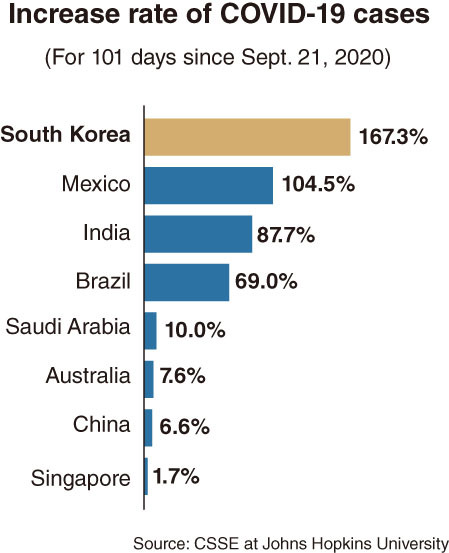[News Focus] Korea’s COVID-19 surge among fastest outside Europe
167%-increase seen in the nation over 3 months
By Kim Yon-sePublished : Jan. 3, 2021 - 16:40

SEJONG -- South Korea has seen a 167.3 percent increase in the number of novel coronavirus infections over the past three months, higher than in major economies in South and Central America as well as in many other Asian nations.
The cumulative tally of COVID-19 cases to date in Korea came to 61,769 as of Jan. 1, compared with 23,106 on Sept. 21, 2020, according to epidemiological data compiled by the Center for Systems Science and Engineering at Johns Hopkins University.
Over the corresponding 101-day period, the increase rate for India, where the cumulative infection tally stood at No. 2 in the world, was 87.7 percent. For Brazil, No. 3 in the world, it was 69 percent.
The pace of growth in COVID-19 cases in Korea was comparable to 193.5 percent of the US (the world’s No. 1 in terms of the cumulative tally) and 186.7 percent of Russia (No. 4). But over the past 30 days, Korea’s daily infection tally has shown a steep gradient and the disease is estimated to have grown faster in Korea than in these two countries.
Korea outpaced 12 major countries in Latin America. These included Argentina, which posted a 157.5 percent growth to 1.64 million during the Sept. 21, 2020-Jan. 1, 2021 period, based on Korean time.
Next were Mexico at 104.5 percent, Panama at 132 percent, Colombia at 114.6 percent, Brazil at 87.7 percent, Honduras at 71.8 percent, Ecuador at 68.2 percent, Guatemala at 62.3 percent and the Dominican Republic at 57.4 percent. Peru, Chile and Bolivia posted increase rates of less than 40 percent.

But in North America, Canada’s 302.7 percent and the US’ 193.5 percent outstripped Korea’s figure, while Mexico’s figure did not.
Among the Asian countries, those where the confirmed epidemic cases grew faster than in Korea included Malaysia (by 1,050 percent to 115,000 as of Jan. 1) and Japan (by 202.5 percent to 239,000 as of Jan. 1).
But the figure for Korea was far higher than Iraq’s 86.8 percent, Pakistan’s 57.5 percent, Bangladesh’s 46.8 percent, Saudi Arabia’s 10 percent, China’s 6.6 percent and Singapore’s 1.7 percent.
Looking at Africa and Oceania, Korea’s figure surpassed Ethiopia’s 82.3 percent, Egypt’s 35.2 percent, Ghana’s 17.3 percent and Australia’s 7.6 percent.
Meanwhile, Europe recorded the highest growth in infections among the six major continents over the corresponding period.
Greece posted growth of 820 percent, followed by Switzerland with 804 percent, the Netherlands with 708 percent, Denmark with 621 percent, Italy with 607 percent, Germany with 542 percent and Belgium with 533 percent.
While figures for the UK and France still remained high at 528 percent and 445 percent, respectively, Sweden -- whose cumulative infection tally had been similar to that of China for months -- experienced a 396 percent surge from 88,000 on Sept. 21 to 437,000 on Jan. 1.
CSSE data showed that the worldwide tally of infections climbed by 168.4 percent from 31.1 million in 188 countries to 83.5 million in 191 countries over the same period.
As of Jan. 2, 18 countries recorded cumulative infection figures over 1 million. Another 58 countries had totals between 100,000 and 1 million, and Korea was among 15 countries with totals between 50,000 and 100,000.
Among the 50 states in the US, California topped the list with 2.3 million infections, trailed by Texas with 1.7 million, Florida with 1.3 million, New York with 995,000, Illinois with 963,000, Ohio with 700,000 and Georgia with 677,000.
The death toll from the pandemic in the US was highest in New York at 38,155, followed by Texas at 28,253, California at 26,286, Florida at 21,673 and New Jersey at 19,160.
By Kim Yon-se (kys@heraldcorp.com)









![[KH Explains] How should Korea adjust its trade defenses against Chinese EVs?](http://res.heraldm.com/phpwas/restmb_idxmake.php?idx=644&simg=/content/image/2024/04/15/20240415050562_0.jpg&u=20240415144419)








